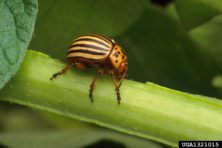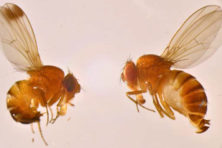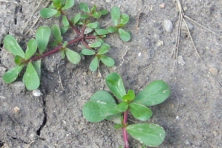Pest Profile: Septoria Leaf Spot and Early Blight of Tomatoes
- Share
- Tweet
- Pin
- Share

Effective pest management is only possible when you know: the pest, when the pest is most susceptible to a treatment, if there’s enough damage caused by the pest to warrant a treatment, and the appropriate control measure based on these variables.
These four steps hold regardless if the pest is a weed, insect, animal or disease.
Diseases of tomato plants are common and there are many different pathogens that can infect them. In Wisconsin, two common fungal diseases are Septoria leaf spot and early blight. The only way a plant disease can develop is if the susceptible host plant is present, the pathogen is present, and environmental conditions are conducive for the pathogen. Only having two of those three factors will not lead to a plant disease.

Photo by William M. Brown Jr., Bugwood.org.
When it comes to Septoria leaf spot and early blight, they both grow on tomatoes (and other closely related plants), they both are common so the pathogen is often present, and they both thrive in humid environments, which is also not unusual in a Wisconsin spring/summer. Therefore, it’s likely you’ll encounter these diseases in your home garden.
Septoria leaf spot is caused by the fungus Septoria lycopersici. Typically, symptoms of Septoria leaf spot will start to appear around the time the tomato plant canopy is filling in, although it can appear at other times. If infected, you will see small, round spots on the leaves at the base of the plant, and they will work their way upward. The spots are approximately ¼-inch wide with a light-colored center and dark perimeter.
As the disease progresses, multiple spots may merge together, eventually killing the leaf. Severe infestations of Septoria leaf spot can lead to total defoliation of the plant and possible plant death.
Early blight is caused by the fungus Alternaria solani. Early blight appears around the same time as Septoria leaf spot and also starts at the base of the plant. Despite the name “early blight” it can appear at any time throughout the growing season. Early blight lesions will be brown, roughly circular spots on the lower leaves and stem, which also move up the plant. However, unlike Septoria leaf spot, as these lesions enlarge, they will start to have target-like rings inside the lesion and are often surrounded by a yellow halo. These lesions may eventually merge, kill the leaf, defoliate the plant, and possibly lead to plant death.
Once a tomato plant shows symptoms of either disease, it can be difficult to control so prevention is the best option. Both pathogens thrive in humid environments so increased air flow is very important. To reduce the humidity around the plant you can:
- Remove a few branches from the lower part of the plant to allow for better airflow at the base;
- Space plants three to four feet apart;
- Stake the plants to keep them off the ground;
- Water only at the base of the plant (not overhead watering) and early in the day so the leaves have time to dry.
In addition to those steps, it is important to minimize the amount of the pathogen present in your garden. The fungi overwinter on infected foliage in the soil so it may help to:
- Apply about one inch of mulch around the base of the plant to minimize water and soil (and therefore the pathogen) from splashing onto the leaves. Do not overmulch or that can lead to other problems.
- At the end of the season remove all infected leaves from the garden or, if not possible, bury or till them in so they will decompose.
- Pick off and destroy leaves that are showing signs of disease throughout the summer, but don’t remove more than a third of the plant’s foliage. Remove the entire plant if the disease is severe.
If you have had severe disease pressure in the past, and have tried many of these methods, you may consider using a fungicide but they can have variable responses. Fungicides containing copper or chlorothalonil may work and should be applied to the plant about a week after transplanting with additional sprays every seven to 10 days after that depending on how wet and humid it is. Before applying any fungicide, make sure to read the entire label to ensure you use the product correctly since the label is the law.

Annie Deutsch
If you still can’t get control of these diseases, buy plant disease-resistant varieties when possible, but unfortunately there aren’t many tomato varieties resistant to Septoria leaf spot or early blight. It might be best to plant something other than tomatoes (or closely related plants including peppers, eggplants or potatoes) in that area of your garden for a few years.
Remember, there are many reasons your tomato plants may be damaged beyond these two diseases. If you would like more information on tomato diseases or to get a tomato disease identified, visit the UW Plant Disease Diagnostic Clinic website, pddc.wisc.edu, (charges may apply for disease identification), or stop by the Door County UW-Extension office at the Door County Government Center in Sturgeon Bay.




